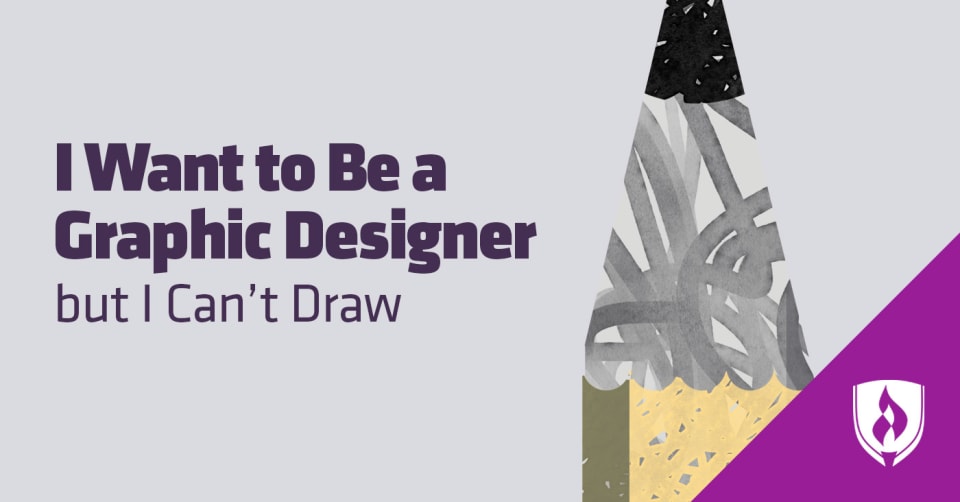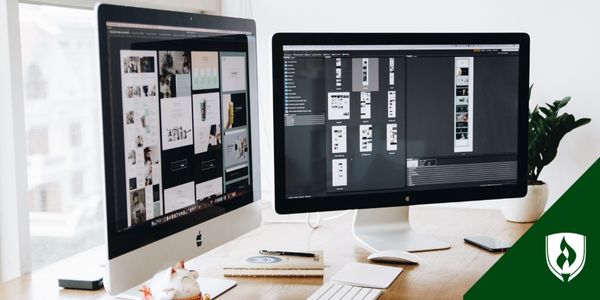
So, you want to be a graphic designer. You have an eye for detail, you love working with both technology and people and you’re excited by the thought of communicating visual messages to a large audience.
The only problem? You’re not exactly an expert drawer. The good news is you’re not alone! And you certainly don’t have to lay aside your career goals just because you’re not the next da Vinci.
In fact, drawing skills generally aren’t even a requirement in most graphic design job descriptions. In an analysis of more than 46,000 graphic design job postings, eight of the top 10 skills in highest demand are associated with design software.* You’ll be even more relieved to know that drawing isn’t even listed in the top 25.
So you can take a deep breath, because the graphic design professionals we spoke with agree that a lack of drawing skill definitely isn’t a deal-breaker. There are plenty of other skills you can wield to thrive in the industry. Keep reading to learn their advice for overcoming your concern.
5 pieces of advice for designers without drawing skills
1. Leverage technology
Where pen and paper fail you, a computer or tablet may be your saviors. Chelsey Moter, a digital analyst for seoWorks, has a degree in graphic design but “simply can’t draw.” She says that in her experience, composing good art has little to do with drawing. You can apply your creative vision just as successfully with design software.
“One way to create good art without drawing is by finding or taking an image, importing into Adobe Illustrator, making it a template, adding a new layer and creating outlines with the pen tool,” Moter explains. “This is a good way to form the shape of something that you want to create.”
She adds that you can also use technology to brush up on your drawing skills. There are several drawing programs and products available to help you become a better drawer. She recommends Bamboo, a tablet that connects to your computer and integrates with Photoshop or Illustrator.
2. Use good communication skills
Are you an expert communicator? You’re in luck, according to Darlene Susco, a designer and founder of iDsusco. She believes the ability to effectively communicate a message to your audience is more important than drawing.
"Graphic design is about communication, not drawing."
“Graphic design is about communication, not drawing. It is the means to create an emotional connection to a message and elicit the desired action from the reader,” Susco says. “The designer’s job is to identify and be able to articulate the point of a message, the essence of a brand and how they are advanced by the idea you are presenting.”
Alvaro Moran, creative director of Boatsetter, agrees with Susco. He says aesthetics is a secondary priority. “Clearly communicating the message to the audience always trumps the beauty of the design,” he adds.
3. Learn the basics of design
Unlike drawing, many of the skills you will need to thrive in a graphic design career can be taught, according to Kandra Churchwell, a designer at Phases Design Studio.
“While you don’t have to be a Picasso or Monet, you do need to understand the basics of design, all of which can be learned,” Churchwell explains. “Graphic design differs from fine art when you consider the technical knowledge that a graphic designer needs.”
To excel as a graphic designer, you need to master everything from how to operate design software, color theory, typography, composition, user experience (UX), the psychology behind marketing and so much more. These fundamentals of design are things you’ll acquire in most graphic design programs.
4. Practice simple sketching
Graphic design may not require professional drawing skills or a fine art background, but UX designer Isaac Hammelburger says simple sketching can get the job done.
“I can’t draw and it used to be a real hindrance until I discovered the art of simple sketching,” Hammelburger says. “With simple sketching, the point is to think about the message you’re trying to drive and then draw simple figures to showcase it.”
Bill Sattelmeyer, Rasmussen University School of Design dean, supports this claim. “Do designers have to be great artists? Absolutely not,” he says. “Essentially, all a designer needs to know is how to sketch out basic design content.”
5. Find your niche in a more technical field
"...you can find success regardless of their drawing talent."
Luckily, design is a growing industry. If you’re not interested in drawing, Erin Morris, founder of Evergreen Design Studio, suggests seeking out a specialized role in a more technical field. You may not realize how many unique types of graphic design jobs are really out there.
“Graphic design has become such a broad field encompassing roles ranging from the technical and analytical to the visual and illustrative,” Morris explains. “If you're not good at drawing and don’t aspire to be, you can focus on the more technical fields like user interface design and UX design.”
Put your worries aside
You can no longer use your artistic abilities (or lack there of) as an excuse for not pursuing a profession in graphic design. Sattelmeyer encourages aspiring designers to pursue their dreams regardless of their drawing talent.
“There’s no need to worry over having to become an accomplished illustrator,” he says. “As long as you can get the point of your designs across to your clients, you can find success despite what you think of your drawing talent.”
Are you ready to overcome your fears and get started on your career path? Get some insiders’ insight on what to expect in our article: What I Wish Someone Told Me Before Becoming a Graphic Designer.
RELATED ARTICLES:
- 7 Things Self-Taught Designers Don’t Know They’re Missing
- What Can You Do With a Graphic Design Degree?
- Is a Graphic Design Degree Worth it or Worthless?
- 6 Stereotypical Horror Movie Characters You May Encounter in Your Real-Life Graphic Design Career
*Burning-Glass.com (analysis of 46,387 graphic design job postings, November 01, 2016 - October 31, 2016).
EDITOR’S NOTE: This article was originally published in January 2014. It has since been updated to include information relevant to 2016.




